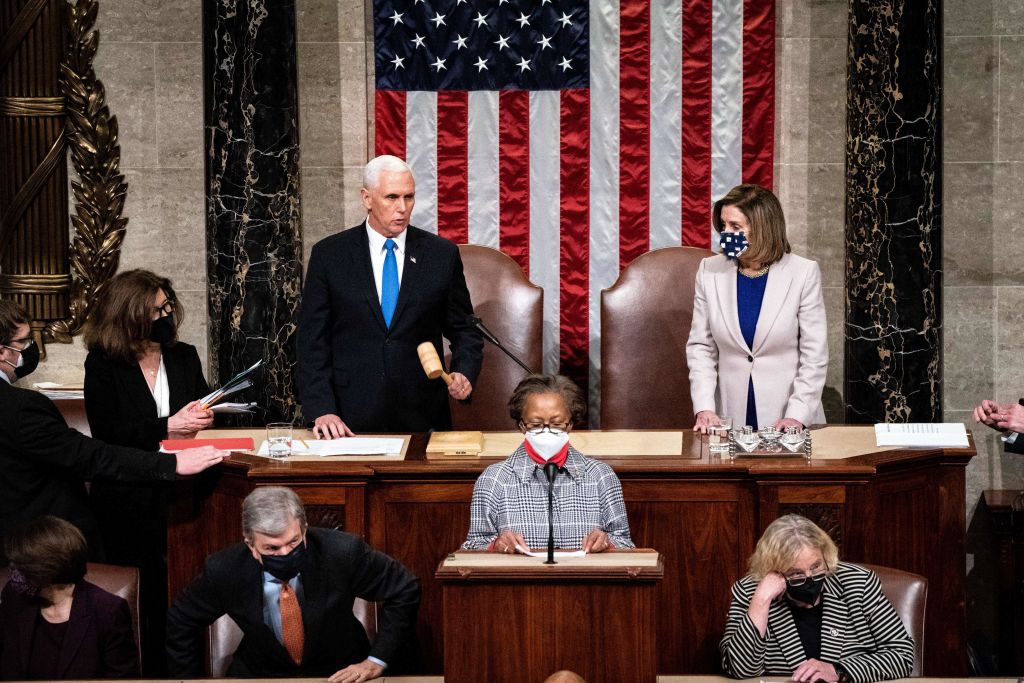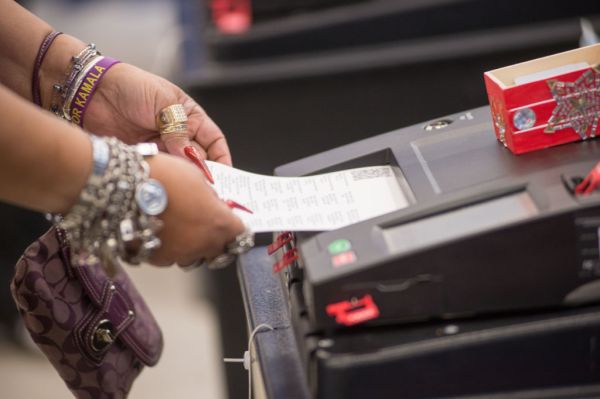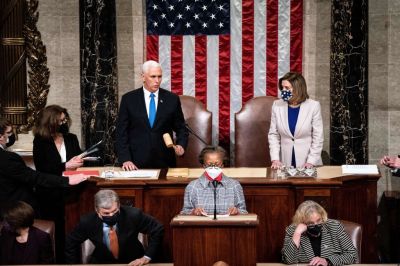The effort to prevent the certification of Electoral College votes on January 6, 2021, was legally possible because of loopholes in the Electoral Count Act of 1887 that some Republicans exploited in an attempt to cast doubt upon the election’s outcome. Nearly two years later, Congress attempted a remedy by passing the Electoral Count Reform Act of 2022. Is this legislative change enough to avoid another January 6 in 2025?
The U.S. Constitution mostly leaves presidential elections to the states, though Congress may decide when electors are chosen and when they must vote (Article 2, Section 1). After the tension of the 1800 presidential election, the 12th Amendment was added to clarify the Electoral College process.
However, the amendment contains no language for resolving disputed Electoral College votes. While the Constitution (Article 1, Section 5) gives each chamber of Congress the power to settle their disputed elections, no entity is empowered for presidential elections. When Congress convened on January 6 to certify the Electoral College votes, efforts to question the legitimacy of Electoral College votes exposed ambiguity in the 134-year-old legislation.
The amendment requires electors, who are chosen by state procedures, to vote for president and vice president separately, and for those votes to be certified and submitted to the president of the Senate, who is also the sitting vice president of the United States. The vice president will “open” the certificates and count them. Congress only witnesses the proceedings unless no candidate obtains a majority of Electoral College votes. In that case, the House selects the president, and the Senate chooses the vice president.
Why did Congress pass the Electoral Count Reform Act?
The election of 1876, when several states submitted more than one slate of Electoral College voters, exposed the need for a means to resolve such disputed outcomes. In response, the Electoral Count Act of 1887 elaborated and expanded on the 12th Amendment. First, it empowered Congress to decide between competing slates of electors, though some of its language about electors that have “not been so regularly given” suggests Congress could intervene whenever irregularities exist. Second, the act allowed members to raise objections to electors and it set a low threshold for doing so. One representative and one senator can force a debate and trigger a vote. A majority of each house is needed to reject electors.
Third, the act cast the president of the Senate as the “presiding officer” over the meeting of Congress and enjoined him or her to “preserve order” and call for objections during the tabulation. Fourth, the act contained a provision that if states “failed to make a choice” on Election Day, state legislatures could decide how to appoint electors.
All these elements were exploited between November 3, 2020, and January 6, 2021, by President Donald Trump, his advisers, and members of Congress. As early as November 6, Florida Gov. Ron DeSantis and media personality Mark Levin called on state legislatures to intervene in contested states.
John Eastman, a constitutional lawyer, wrote a memorandum that detailed how Trump could hold onto power. Eastman’s argument was that under the guise of fraud that had produced a “failure” to select electors under appropriate procedures, multiple slates of electors could be encouraged from the contested states. “Unofficial” electors from Arizona, Georgia, Michigan, Nevada, and Wisconsin did transmit information to the Office of the Federal Register, which is attached to the National Archives and receives official state information related to the Electoral College.
This gambit, Eastman believed, would allow Vice President Mike Pence, upon objection from members of Congress, to set aside electoral votes from those states. Trump pressured Pence to follow along, though Pence was told by aides and confidants he lacked that authority under the Electoral Count Act. Pence, on January 6, released a letter affirming that his role was ministerial as opposed to discretionary, and that he could not set aside Electoral College votes on his own.
When Congress was convened, Rep. Paul Gosar and Sen. Ted Cruz, both Republicans, objected to Arizona’s Electoral College votes. Cruz argued Congress has a “responsibility under the Constitution to consider serious claims of voter fraud.” As the House and Senate debated the objections, the Capitol was breached by protesters. Roughly six hours later, Congress reconvened, and Pence certified Joe Biden as president of the United States.
After the tumult, calls to reform the Electoral Count Act came quickly and from across the ideological spectrum.
What does the Electoral Count Reform Act change?
The new legislation, the Electoral Count Reform and Presidential Transition Improvement Act of 2022, plugs some of the old law’s holes. The act removes the possibility of a “failed election” by limiting state legislative efforts to choose electors after an election to cases of force majeure, like a natural disaster. Claims of fraud are no longer sufficient for legislative action.
The president of the Senate’s role is now formally limited to “ministerial duties.” The sitting vice president has “no power to solely determine, accept, reject, or otherwise adjudicate or resolve disputes over the proper list of electors, the validity of electors, or the votes of electors.”
The legislation still allows Congress to object to some electors and to sustain those objections with a majority vote from each chamber, but now a vote of one-fifth of the members of each house is needed to trigger the process. The act also tightens the grounds for objection to electors that are not lawfully certified by the state or if the elector’s vote is not “regularly given.” This term is connected to the propriety of the ballot—perhaps an elector votes for an ineligible candidate, on the wrong day, or while under an improper influence.
The new law also provides a direct role for federal courts to handle candidate claims regarding electors. Cases are to be heard in district courts by three judges, one from the federal district and two from the corresponding Circuit Court of Appeals. Decisions could then be appealed directly to the U.S. Supreme Court.
Will the new law prevent another January 6?
The Electoral Count Reform Act should simplify what happens when Kamala Harris, as president of the Senate, certifies the election results next year—whether she wins the presidential election or not. While objections are possible, and electors could be disqualified, the law prescribes a process for the federal courts to adjudicate disputes. Congress could attempt to overturn election results through an act of will, but that seems unlikely to survive legal challenges given the new law.
What happens outside of Washington, D.C., could be more complicated. Trump’s allies, or Harris’ if roles are reversed, could use lawsuits, recounts, and false information to generate distrust in the certification process at the state and local level. These delays could make it difficult for swing states to meet the Electoral Count Reform Act’s deadlines for choosing electors (Election Day, November 5), certifying electors (December 11), voting by the electors (December 17), and the counting of the votes (January 6, 2025).
State or county boards of election could refuse to certify election results or impose standards that would delay counting. This could prevent a rival party from claiming Electoral College votes from that state, or it might encourage a state legislature to install its own slate of electors–regardless of the new federal law. This would involve a challenge to the constitutionality of the ECRA.
Such things are already being attempted. The Georgia State Election Board passed a rule requiring county election workers to hand-count ballots in each precinct. Trump lauded the decision, which could delay reporting and certification significantly, while local election officials and some statewide Republicans were critical. On October 15, Fulton County Supreme Court Judge Robert McBurney approved a temporary injunction that prevents the rule from going into effect for this cycle, but an appeal by Republican groups is pending.
In Nevada, three Republican commissioners in Washoe County refused to certify an election recount in July. Two of the commissioners later reversed course to avoid a nasty legal conflict. Washoe is the second largest county in Nevada, and its voters and election officials will help decide who wins the state’s Electoral College votes in November.
While the Electoral Count Reform Act has stabilized elements of presidential elections, the rest of the system is still being tested. Unless the election results are decisive, expect legal and political challenges to once again extend the cycle into 2025.





Please note that we at The Dispatch hold ourselves, our work, and our commenters to a higher standard than other places on the internet. We welcome comments that foster genuine debate or discussion—including comments critical of us or our work—but responses that include ad hominem attacks on fellow Dispatch members or are intended to stoke fear and anger may be moderated.
With your membership, you only have the ability to comment on The Morning Dispatch articles. Consider upgrading to join the conversation everywhere.